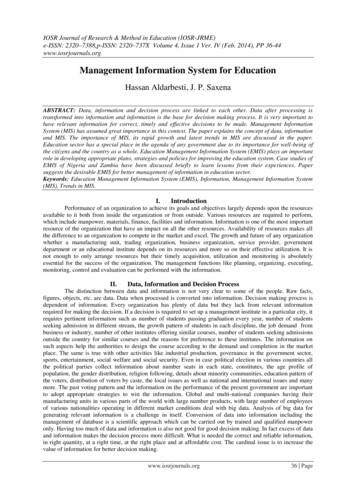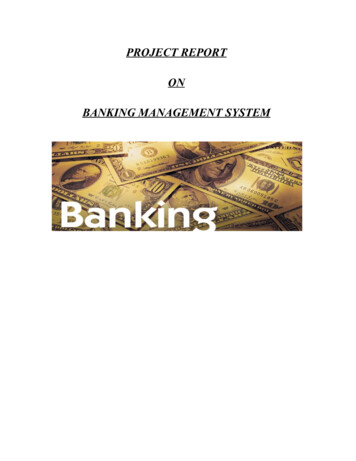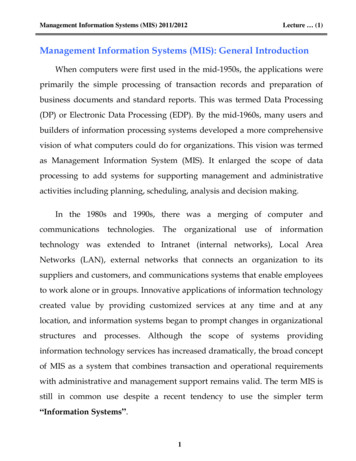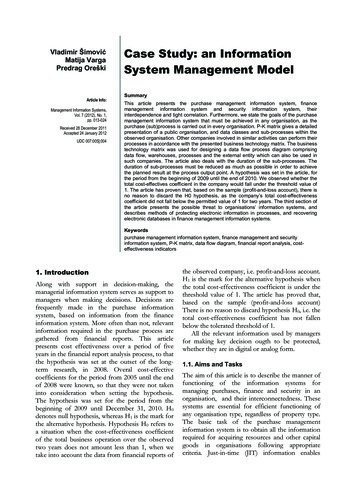
Transcription
IOSR Journal of Research & Method in Education (IOSR-JRME)e-ISSN: 2320–7388,p-ISSN: 2320–737X Volume 4, Issue 1 Ver. IV (Feb. 2014), PP 36-44www.iosrjournals.orgManagement Information System for EducationHassan Aldarbesti, J. P. SaxenaABSTRACT: Data, information and decision process are linked to each other. Data after processing istransformed into information and information is the base for decision making process. It is very important tohave relevant information for correct, timely and effective decisions to be made. Management InformationSystem (MIS) has assumed great importance in this context. The paper explains the concept of data, informationand MIS. The importance of MIS, its rapid growth and latest trends in MIS are discussed in the paper.Education sector has a special place in the agenda of any government due to its importance for well-being ofthe citizens and the country as a whole. Education Management Information System (EMIS) plays an importantrole in developing appropriate plans, strategies and policies for improving the education system. Case studies ofEMIS of Nigeria and Zambia have been discussed briefly to learn lessons from their experiences. Papersuggests the desirable EMIS for better management of information in education sector.Keywords: Education Management Information System (EMIS), Information, Management Information System(MIS), Trends in MIS.I.IntroductionPerformance of an organization to achieve its goals and objectives largely depends upon the resourcesavailable to it both from inside the organization or from outside. Various resources are required to perform,which include manpower, materials, finance, facilities and information. Information is one of the most importantresource of the organization that have an impact on all the other resources. Availability of resources makes allthe difference to an organization to compete in the market and excel. The growth and future of any organizationwhether a manufacturing unit, trading organization, business organization, service provider, governmentdepartment or an educational institute depends on its resources and more so on their effective utilization. It isnot enough to only arrange resources but their timely acquisition, utilization and monitoring is absolutelyessential for the success of the organization. The management functions like planning, organizing, executing,monitoring, control and evaluation can be performed with the information.II.Data, Information and Decision ProcessThe distinction between data and information is not very clear to some of the people. Raw facts,figures, objects, etc. are data. Data when processed is converted into information. Decision making process isdependent of information. Every organization has plenty of data but they lack from relevant informationrequired for making the decision. If a decision is required to set up a management institute in a particular city, itrequires pertinent information such as number of students passing graduation every year, number of studentsseeking admission in different stream, the growth pattern of students in each discipline, the job demand frombusiness or industry, number of other institutes offering similar courses, number of students seeking admissionsoutside the country for similar courses and the reasons for preference to these institutes. The information onsuch aspects help the authorities to design the course according to the demand and completion in the marketplace. The same is true with other activities like industrial production, governance in the government sector,sports, entertainment, social welfare and social security. Even in case political election in various countries allthe political parties collect information about number seats in each state, constitutes, the age profile ofpopulation, the gender distribution, religion following, details about minority communities, education pattern ofthe voters, distribution of voters by caste, the local issues as well as national and international issues and manymore. The past voting pattern and the information on the performance of the present government are importantto adopt appropriate strategies to win the information. Global and multi-national companies having theirmanufacturing units in various parts of the world with large number products, with large number of employeesof various nationalities operating in different market conditions deal with big data. Analysis of big data forgenerating relevant information is a challenge in itself. Conversion of data into information including themanagement of database is a scientific approach which can be carried out by trained and qualified manpoweronly. Having too much of data and information is also not good for good decision making. In fact excess of dataand information makes the decision process more difficult. What is needed the correct and reliable information,in right quantity, at a right time, at the right place and at affordable cost. The cardinal issue is to increase thevalue of information for better decision making.www.iosrjournals.org36 Page
Management Information System for Education2.1Types of InformationHarsh, Connor & Schwab [1] suggested a classification of information into four categories: DescriptiveInformation, Diagnostic Information, Predictive Information and Prescriptive Information (Fig.1).Fig. 1: Classification of information – Examples of Education System2.1.1Descriptive informationStaring point in the classification of information is the descriptive information, which is the base for allother types of information. Descriptive class of information scenario building of the business at a particularpoint of time. As an example of an education system, it deliberates about:a. Number of students enrolled,b. Disciplines and the courses running,c. Placement process in vogue and its success,d. Marketing strategy adopted and its impact on the enrollment, ande. Recognition of its courses by the end users like industry, business houses, educational institutes andgovernment etc.2.1.2Diagnostic informationDiagnostic information provides insight in to the problems. What are the reasons of the problems?What has not been done? What should have been done? These are the areas of coverage of diagnosticinformation. The types of information needed in this class of information in case of the education institutes are:a. Why the registration of students is below expectation?b. Where is more registration and why?c. Which courses are more popular?d. What are reasons of students taking admission in this institute?e. Has the marketing strategy adopted given commensurate results?f. Why students initially registered switched over to other institution?g. Is the fees charged for the course competitive in comparison to other contemporary institutes? Based on thediagnostic information education planners and regulators set norms and standards. Gap analysis is carriedout to identify the areas of concerns as well as areas of opportunities. The information available is used forappropriate action plans.2.1.3Predictive informationPredictive information is relating to question “What if .?” This class of information helps inanalyzing the future strategies to be considered and adopted. This information attempts to identify the desirableoutcomes. The predictive information is vital for forecasting, planning future strategies, looking for resourcemobilization in coming years and what type of marketing strategies will be more practical. Budgetingtechniques, simulation models and other management tools adopted by the organizations use predictiveinformation extensively.www.iosrjournals.org37 Page
Management Information System for Education2.1.4Prescriptive informationPredictive information addresses the question of what should be done and what can be done. The basicsource for such analysis is the domain of predictive information. The output of the predictive information isdeliberated in the context of goals and values set for the organization. For example, an education institute mayoffer integrated courses which ensure the students for a steady education at a later date when they have to forhigher education. The competition at that stage may be very critical. But a student of the same institute will havemore chances to get admission in higher courses due to intimate knowledge of the standard and norms of theinstitute. Even the institute have more confidence on the likely performance of its own students. Some of theinstitutes offer dual degree where in part of the education is done in the mother institute and par of the educationis imparted in an institute in another country. This institute can be the institute of the mother institute which hasenrolled the student initially or in another institute totally independent identity but having a collaborativearrangement with the mother institutes. Students get a great advantage of world class exposer by studying in aforeign university which otherwise is beyond his means. The quality of education improves with such worldclass interactions. Students have an opportunity of interacting with world class faculty, study in a dreamenvironment and compete on a world class syllabus as well as with world class student community.III.Management Information System (MIS)Correct decision making is possible with the efficient utilization of information. In view of the largedata and information available to the managers, the decision making process becomes very difficult. Informationrequired for decision making should be easily available [2]. Collection of data, its conversion to the information,proper storage of information, retrieval of information and effective utilization of information need ManagementInformation System popularly known as MIS. Management Information System is a computer based system. Itis a very strong tools available to managers for planning, organizing, executing, monitoring, control andevaluation of their operations efficiently. MIS Facilitates effective communication.MIS consists of three basic components: Management, Information and the System. Integrated use ofthese three components enables clarity in understanding the issues involved, impact of each component on otherseemingly independent inputs but interconnected with each other. The decisions taken in this way is appropriatein the context of the business requirements. MIS enables to adopt multi-disciplinary management approachconsidering all the aspects relating to operational, financial, materials, behavioral, organizational practices andpolicies; and computer related issues. Organization works in holistic manner with the help of MIS rather than indifferent segments. Decisions in different segments without taking a holistic approach have greater chances offailure. There is tremendous avoidable waste in utilization of organizational resources.3.1MIS supports organizational systemsOrganizational structure basically can be divided in three layers of hierarchy: top management level,middle management level and lower management level (Fig. 2). Each level takes decisions according to theirroles.Fig. 2: Decision areas and management levelsThe lower level managers are involved in operational decisions, middle level managers‟ focus on thetactical decisions and top level managers concentrate on strategic decisions. Most of the routine activities areplanned, executed and managed by lower level managers for example planning, scheduling and ensuring that allthe plans are implemented as decided. Middle level managers spend relatively less time on the routine planningactivities and focus more on tactical decisions such as problem solving, gap analysis, performance appraisal andadvertising. The role of top managers is very different than the lower level and middle level managers. Theymostly concentrate on the strategic issues like which product should be launched in the market, which marketshould be tapped, how to make entry into the domain of the competitors, how to arrange for various resources,how to improve productivity of the organization, how to reduce cost, with whom to collaborate, whether tocomputerize, to what extent computerization should be implemented, how to train the manpower to match withwww.iosrjournals.org38 Page
Management Information System for Educationtechnological challenges likely to be faced etc. Table 1 shows the level of management hierarchy in anorganization, related decision making roles and the type of informations required by them.Table 1: Types of information, management levels and types of decisionsTypesofinformationLevelsofmanagersTypes of DecisionMakingExamples of information from educational perationalLeveloperational /MiddleLevelPolicy making andsrategic decisionsTactical tical decisionsDaily schedule of lectures, Teacher absent,. Alternate arrangement for teacher.Why classesdo not start in time?Why students come late?Why teachers are late in the class?Why projector or mic does not work satisfactorily?How to ensure that classes start at right time?How to improve up-time of projectors and mic systems in theclass rooms.PrescriptiveInformationTop LevelStrategic decisionsIV.How the administrative staff arranges the classes?Functioning of bio-metric system for attendanceInformation Explosion and Rapid GrowthIn early 1950s, manufacturing units felt a need for better management of operations. Data was neededto schedule the manufacturing activities so that resources of the company are optimally utilized. Wastage due toimproper planning in absence of the required data and the information prompted the industry to collect therelevant data required by it for planning, organizing and control of various activities. Computers were alsointroduced at this time. The need of the business and availability of computers witnessed the beginning ofManagement Information System (MIS). The purpose o
System (MIS) has assumed great importance in this context. The paper explains the concept of data, information and MIS. The importance of MIS, its rapid growth and latest trends in MIS are discussed in the paper. Education sector has a special place in the agenda of any government due to its importance for well-being of the citizens and the country as a whole. Education Management Information .










